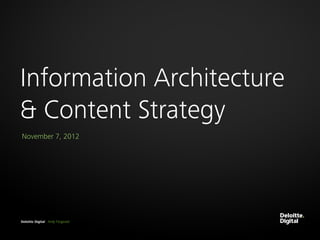
Information Architecture & Content Strategy
- 1. Information Architecture & Content Strategy November 7, 2012 Deloitte Digital Andy Fitzgerald
- 2. Information Architecture & Content Strategy Context: why now? Information Architecture & Content Strategy defined IA & CS integration with current processes IA & CS in action What next: participating, getting involved & learning more
- 3. Context
- 4. Übermind
- 5. Showtime Anytime showtime tablet image
- 7. Current Process Some wins: Translation, not “porting” Targeting consistent brand experience, as opposed to identical visual/interaction experience Remaining challenges: Work is informed by technology-specific organization Adaptation work must be repeated for each new platform Each design is ultimately not forward compatible
- 8. Information architecture & content strategy
- 9. “Architecture enables environments for inhabitation; information architecture enables environments for understanding.” –Jorge Arango, “Architectures”
- 10. Information architecture happens by design or by default.
- 11. Context Content Users Adapted from Information Architecture for the World Wide Web, by Louis Rosenfeld & Peter Morville
- 12. Information Architecture IA is the structural design of information systems, interactive services, and user experiences. IA accounts for the organization, search, and navigation systems that help people to complete tasks, find what they need, and understand what they’ve found. Adapted from Information Architecture for the World Wide Web, by Louis Rosenfeld & Peter Morville
- 13. Information Architecture Taxonomies & ontologies Controlled vocabularies Navigation maps Metadata maps Search functionality specifications Use cases User flows Strategy reports
- 14. Information Architecture Builds bridges between: Users & content Strategy & tactics Platforms & channels Research & practice
- 15. Content Strategy CS is the practice of planning for the creation, delivery, and governance of useful, usable content. CS tasks create a quantitative and qualitative assessment of site or application content in order to identify surplus and gaps and to plan for the site or application’s future needs. Adapted from Content Strategy for the Web, by Kristina Halvorson
- 16. Content Strategy Content audits & inventories Metadata framework assessments Gap analyses Page tables Content style guides Process workflow diagrams
- 17. Content Strategy Identify and plan for content that: Supports key business objectives Supports users in completing tasks Supports consistent brand messaging Supports consistent user experience across multiple contexts & devices
- 18. What vs. How Together, Information Architecture and Content Strategy describe “what.” Once an agreed-upon understanding of “what” is established, subsequent design phases (interaction design, visual design) can move on to “how” with a clear sense of the goals and priorities of the underlying value proposition.
- 19. Integration
- 20. 2011 UX Process
- 23. Proposed UX Process Integrates research into Identifies content & entire design process capability gaps early on Clarifies project goals Simplifies interaction Creates a scalable IA design decisions foundation Creates accountability
- 24. Proposed UX Process Working deeper in the value stack Focusing more on activities, less on artifacts
- 25. Pace Layering
- 26. Pace Layering As applied to information design: content & value proposition are “slow-moving” layers navigation schema, interaction models & device deployment are “fast-moving” layers Understanding the role of each layer allows us to: purposefully adjust individual components pivot instead of react when confronted with new contexts, constraints & opportunities
- 27. Focus on Activities over Artifacts Cross-disciplinary discovery & ideation Project-tailored tasks Heuristics-based analysis Emphasis on problem solving Deliverables as the result of activities
